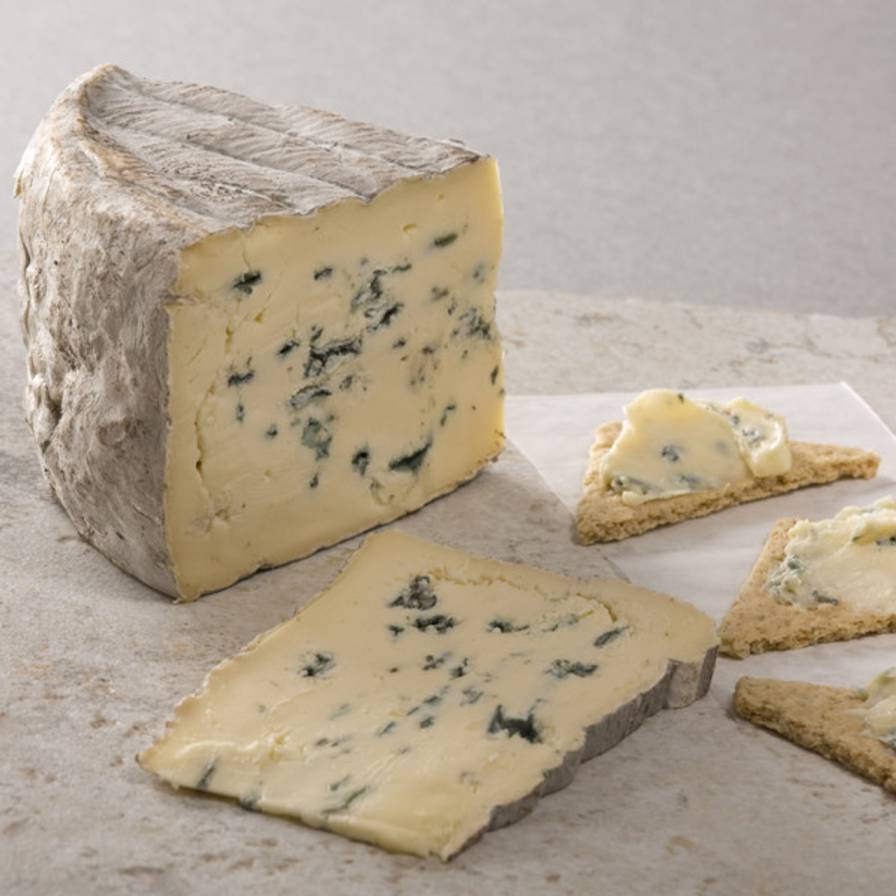What is Cambozola? Germany’s Unique Hybrid Cheese

Cambozola, a distinctive hybrid cheese from Germany, is a delightful blend of creamy Italian Gorgonzola and French triple cream soft-ripened cheese. Known for its rich and creamy texture with the tang of blue mold, Cambozola offers an exceptional culinary experience that has charmed cheese lovers worldwide.
Quick Facts About Cambozola
| Quick Facts | Details |
|---|---|
| Origin | Germany |
| Type | Soft-ripened |
| Made From | Cow’s milk |
| Texture | Creamy and smooth |
| Color | Pale yellow with blue veins |
| Flavor | Mild, slightly pungent |
| Aroma | Musty, earthy |
| Rind | Edible, bloomy |
| Fat Content | High, up to 75% |
| Aging Time | At least 3 weeks |
| Also Known As | Blue Brie |
| Pairings | Fruits, nuts, honey, bread |
| Wine Pairing | Riesling, Cabernet Sauvignon |
| Beer Pairing | Belgian ales, stouts |
| Producer | Käserei Champignon |
| Shelf Life | Up to 2 weeks in refrigerator |
| Named After | Camembert + Gorgonzola |
| Introduced | Late 20th century |
What is Cambozola?

Hailing from the Allgäu region of southern Germany, Cambozola is a delightful fusion of French and Italian cheese styles. This cow’s milk cheese marries the rich creaminess of French soft-ripened triple cream cheese with the piquant notes of Italian Gorgonzola, creating a unique hybrid that has captivated cheese lovers worldwide.
Cambozola emerged in the 1900s and underwent a revamp to become the show-stopper it is today. Produced by Käserei Champignon, Cambozola stands as a testament to high-quality soft-ripened cheese specialties. Its creamy texture envelops the palate, while its subtle blue veins deliver a gentle, slightly pungent flavor – a harmonious balance that has earned it a place on many special event menus.
The cheese’s distinct character comes from the innovative combination of Camembert and Gorgonzola, hence the name “Cambozola”. With its origins dating back to the early 1970s, this unusual German triple-cream cheese has been enchanting taste buds for decades. Whether served with fruits, spread on bread, or enjoyed on its own, Cambozola promises a gastronomic adventure like no other.
What Does Cambozola Taste Like?
Cambozola cheese is a delightful blend of flavors that bridges the gap between mild and pungent. Its taste can be described as a harmonious fusion of creamy, buttery richness with a subtle hint of tangy blue mold.
The influence of Camembert gives Cambozola a luscious creaminess and smooth mouthfeel, with a mild, slightly sweet, and earthy flavor that is characteristic of this type of cheese. On the other hand, the veins of Gorgonzola introduce a gentle piquancy, adding a touch of sharpness and complexity without overwhelming the palate.
Moreover, Cambozola has a bloomy rind that’s edible and adds a slight mushroomy note to its overall flavor profile. The cheese’s high-fat content contributes to its luxurious texture and rich taste, making it a favorite among cheese connoisseurs.
Whether enjoyed on its own, paired with fruits and nuts, or used in culinary creations, Cambozola offers a unique and indulgent tasting experience.
What is the Difference Between Cambozola and Gorgonzola
Cambozola and Gorgonzola, while both blue cheeses, have distinct differences in their origins, flavor profiles, and textures.
| Feature | Cambozola | Gorgonzola |
|---|---|---|
| Origin | Germany | Italy |
| Flavor | Mild, creamy with a subtle hint of blue flavor | Bold, pronounced blue flavor |
| Texture | Smooth, creamy and spreadable | Crumbly |
| Aging Process | Shorter (3 weeks or more) | Longer (Dolce: 3-4 months), (Piccante: over 6 months) |
| Milk Type | Cow’s milk | Cow’s milk |
| Pairings | Pairs well with sweet white wines like Riesling, robust reds like Cabernet Sauvignon, and dark beers like Belgian ales and stouts | Often enjoyed with full-bodied red wines, honey, and pears |
>> Click here to read our in-depth guide on Gorgonzola
How to Eat Cambozola Cheese?
- Cheese Board: Feature Cambozola on a cheese board with a variety of other cheeses for a balanced flavor profile. Pair it with both hard and soft cheeses to offer a range of textures.
- Pairings: Cambozola pairs exceptionally well with fruits like grapes, apples, and figs, which enhance its creamy quality. It also complements nuts, providing a contrasting crunch. Try drizzling a little honey over the cheese for an added touch of sweetness.
- Beverages: For beverages, Cambozola goes well with sweet white wines like Riesling, robust reds like Cabernet Sauvignon, and dark beers like Belgian ales and stouts. These drinks can balance out the rich, creamy flavor of the cheese.
- Culinary Uses: Due to its creamy texture, Cambozola can be used in a range of dishes. Melt it into pasta sauces or soups for a velvety touch, or use it as a topping for baked potatoes or steamed vegetables.
- Sandwiches and Burgers: You can use Cambozola as a flavorful addition to sandwiches and burgers. Its creaminess pairs well with the texture of bread and the savoriness of meats.
- Appetizers: Spread Cambozola on crackers or thinly sliced baguettes for a simple yet sophisticated appetizer. Top with a slice of pear or apple for a fresh contrast.
- Desserts: Cambozola can even be incorporated into desserts. Try it in a cheese-based dessert recipe, such as a cheesecake or tart, for a unique twist.
- Eating Raw: Of course, you can also enjoy Cambozola all on its own. Savor the cheese at room temperature to fully appreciate its complex flavors and creamy texture.
10 Best Cambozola Substitutes
| Substitute | Description |
|---|---|
| Brie | A French cheese that shares a similar creaminess and mild flavor with Cambozola. However, it lacks the blue veins and piquant flavor of Cambozola. |
| Gorgonzola | An Italian blue cheese that has a stronger flavor than Cambozola but can be used as a substitute due to its similar texture and blue veining. |
| Blue Castello | A Danish blue cheese that is creamy and mild like Cambozola. It’s less pungent than most blue cheeses, making it a suitable alternative. |
| Camembert | A French cheese that is creamy like Cambozola, but without the blue flavor. It melts well, making it a good substitute in recipes. |
| Roquefort | This French blue cheese has a more intense flavor than Cambozola, but can work as a substitute if you enjoy stronger blue cheeses. |
| Cream Cheese | A mild and creamy cheese that can replace Cambozola in recipes where the blue flavor is not crucial. |
| Mascarpone | An Italian cream cheese that is smooth and mild. It lacks the blue veins of Cambozola but can be used as a substitute in certain dishes. |
| Saint Agur | A French blue cheese that is creamy and relatively mild, making it a good substitute for Cambozola in terms of both texture and flavor. |
| Dolcelatte | An Italian blue cheese that is sweet and creamy, similar to Cambozola. It can be used as a substitute in many recipes. |
| Danablu (Danish Blue) | This Danish blue cheese is more pungent than Cambozola, but shares a similar creamy texture and can work as a substitute if you prefer a stronger flavor. |
What Pairs Well With Cambozola?

Food that goes well with Cambozola:
| Category | Foods that pair well with Cambozola |
|---|---|
| Fruits | Berries, grapes, pears, apples, dried fruits like figs, apricots, and dates |
| Nuts | Toasted nuts, walnuts |
| Meats | Salty bacon |
| Pickles | Pickled okra |
| Bread | Grilled cheese sandwiches |
| Dairy | Blue cheese crumbles |
| Sweets | Honey |
Also read: What Fruit Goes on a Charcuterie Board?
Beverage that goes well with Cambozola:
| Category | Beverages that pair well with Cambozola |
|---|---|
| Red Wine | Cabernet Sauvignon, Merlot, Pinot Noir |
| White Wine | Riesling, Chardonnay, Sauvignon Blanc |
| Beer | Belgian ales, Stouts, Porters |
| Dessert Wine | Port, Sherry, Madeira |
| Non-alcoholic | Sparkling water, Apple cider, Grape juice |
Also read: Best Wine and Cheese Pairings: The Ultimate Guide
Frequently Asked Questions
1. Can I eat the rind on Cambozola?
Yes, the rind on Cambozola cheese is edible. It forms as a result of natural ripening and adds another dimension to the flavor profile of the cheese. However, whether or not to eat the rind comes down to personal preference. Some find the texture and taste appealing, while others do not.
2. What is the green stuff in Cambozola cheese?
The green stuff in Cambozola cheese is Penicillium mold. This mold acts as a natural preservative and gives the cheese its unique flavor and appearance. It’s completely safe to eat.
Also read:
- What is Crema Mexicana? The Creamy Crown of Mexican Cuisine
- What is Red Leicester? The Ruby of English Cheeses
- What is Wensleydale? From Monks to Modern Creameries
- What is Truffle Cheese? Savoring the Richness
- What is Babybel? A Snack-Sized Cheese Journey
- What is Humboldt Fog? A Taste of California’s Coastal Pastures
- What is Brin d’Amour? The Corsican Cheese Delight





